The agricultural sector includes emissions from production of livestock and emissions related to the cultivated agricultural area. The emissions sources can be divided into following sub-categories;
In relation to the Danish total emission, the agricultural sector is noted as important contributes for NH3, NOx, TSP, PM10, PM2.5, CH4, N2O and NMVOC. In 2023 the emission shares were 95 %, 21 %, 77 %, 38 %, 9 %, 80 %, 88 % and 46 %, respectively.
According to the IPCC guidelines the emission related to agricultural machinery (tractors, harvesters and other non-road machinery) are reported in the energy sector. The same comment applies to CO2 removals/emissions from agricultural soils, which are included in the LULUCF sector (Land-Use, Land-Use Change and Forestry).
Figure 1 shows the emissions from the agricultural sector, 2023.
 |  |
 |  |
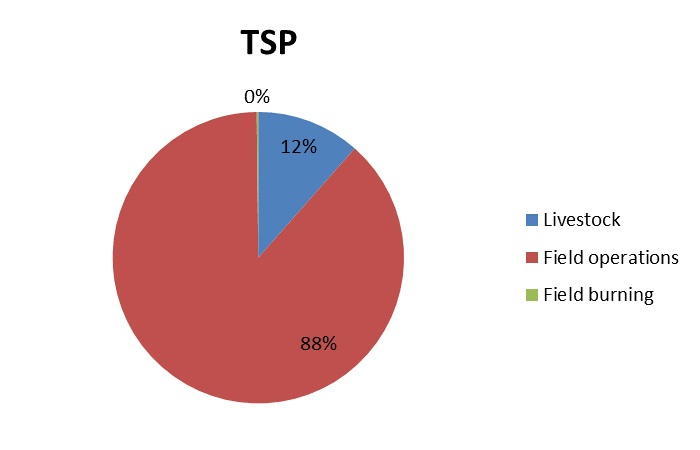 | 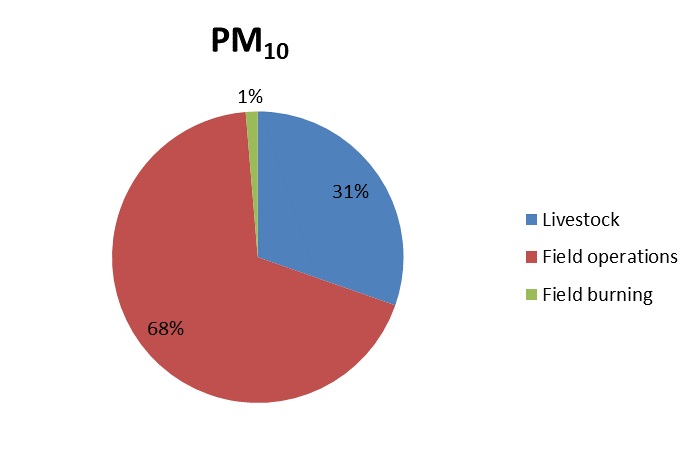 |
The main part of the CH4, N2O, NH3 and NMVOC emissions are related to the livestock production. The PM emissions and especially the TSP emission is dominated by emission from field operations, which includes emissions from crop harvesting, cultivation of soil, and the cleaning and drying of crops.
The most important air pollutant from the agricultural sector is NH3. Approximately 95 % of the national ammonia emission originates from the agricultural sector and the remaining part originates from stationary combustion, traffic and industrial processes. In 1985, the NH3 emission is estimated to 162 kt NH3 and has since decreased to 63 kt NH3 in 2023, which corresponds to a 61 % reduction. The significant decrease of the ammonia emission is a consequence of an active national environmental policy in the last thirty years. A string of measures have been introduced to prevent loss of nitrogen from agriculture to the aquatic environment by implementation of requirements of handling of manure (storage and application), requirements to use of nitrogen content in animal manure. Furthermore, requirements to crops and fertilization e.g. winter green fields to catch nitrogen, a maximum number of animals per hectare and maximum nitrogen application rates to agricultural crops. These measurements has led to a decrease of NH3 emission per produced animal and a decrease in use of inorganic N fertilizer, which all has reduced the overall ammonia emission significant.
The NH3 emission from animal manure (manure management, grazing and manure applied to soil) accounts for 68 % the total agricultural emission in 2023 and the main part occurs from the cattle- and pig production, which is the most important livestock categories regarding the Danish agricultural production. A decrease in emission from cattle taking place from 1985 until 2005, which is mainly driven by a lower emission from application of animal manure to the fields due to the requirements to handling of manure (ban of broad spreading and shorter time on soil before ploughing). Because of increasing milk yield per cow and EUs milk quota system, the number of cattle decreases until 2005. From 2005 and forwards, the NH3 emission is nearly unchanged and also the number of dairy cattle is stable, while the total milk production is increased, which is a result of improvement in the production efficiency. The NH3 emission from the swine production 1985 to 2004 is decreasing despite a significantly increasing of the meat production from 14.6 million produced fattening pigs in 1985 to 25.2 million in 2004. The lower emissions is a consequence of production efficiency in form of lower emission per produced pig caused by feed strategy and genetic development. The requirement to the handling of animal manure also affect the emission reduction, but has a lower influence than for cattle manure. From 2005 and onwards the NH3 emission continue to decrease, which is a result of export of weaners followed by a fall in number of fattening pigs raised in Denmark.
The agricultural PM emission given as PM10 covers 38 % of the overall Danish PM10 emission in 2023. The emissions sources from agricultural activities includes emission form dust in animal housing, field operations and field burning of agricultural residues. The agricultural PM10 emission in 1985 is estimated to 12.5 kt PM10 decreased to 8.0 kt PM10 in 2023 corresponding to a 36 % reduction. The main part of the reduction taken place from 1985 – 1990 due to the banning of field burning in 1990. From 1990 until 2023 the decrease is mainly due to lower emission form field operations (harvesting).
Figure 2: Time-series for NH3 and PM10 emissions from the agricultural sector, 1985-2023.
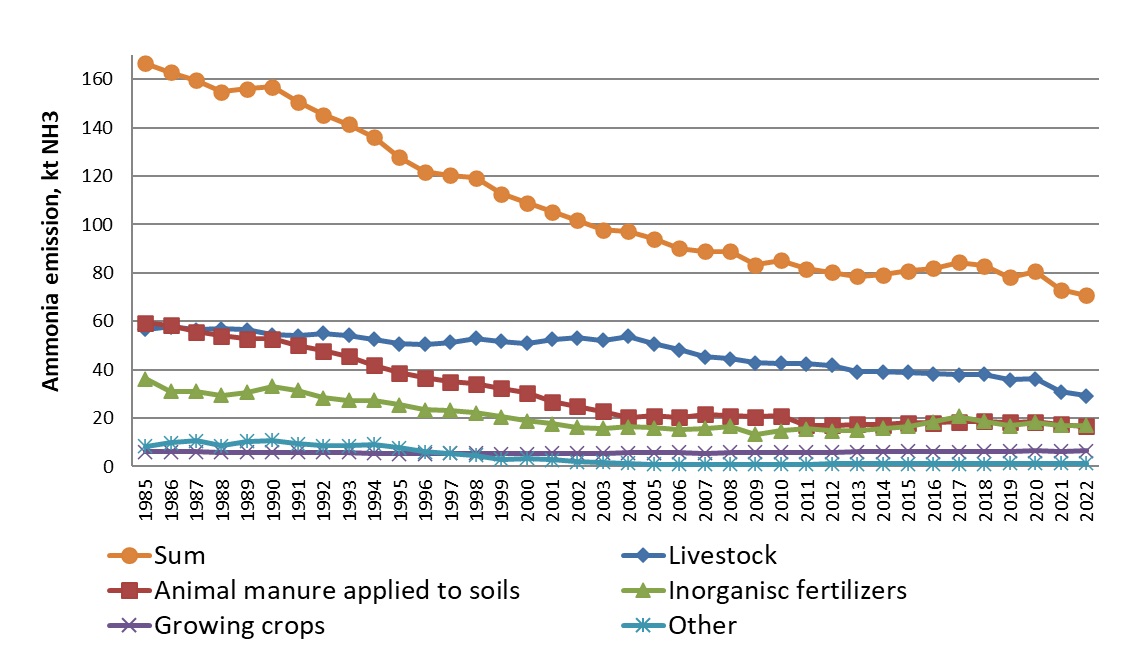 | 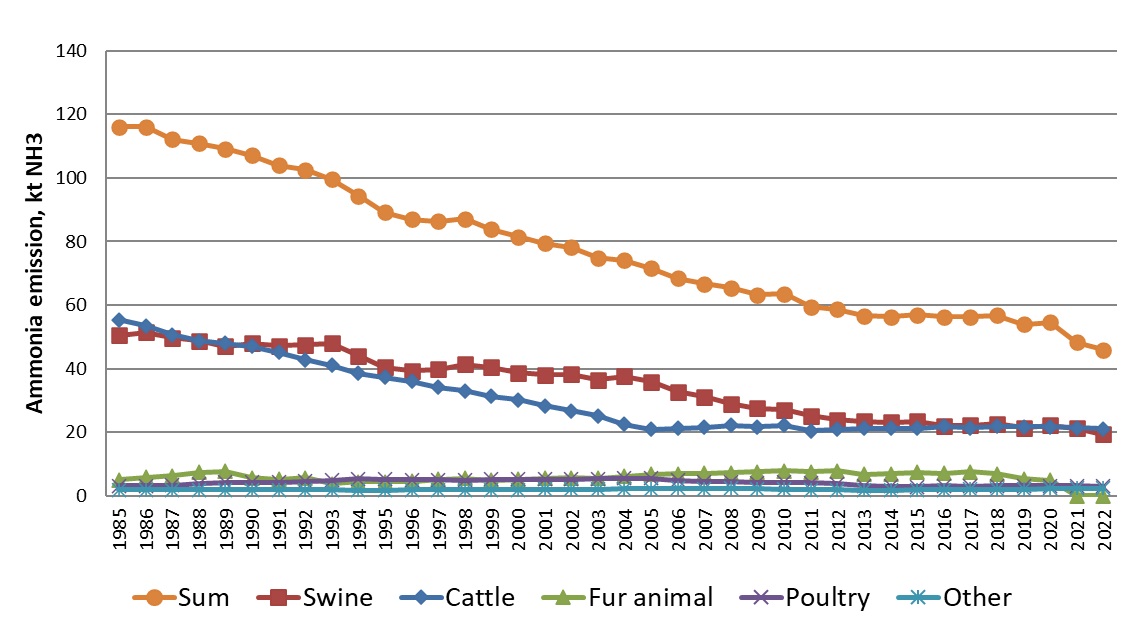 |
|---|---|
| Click here for background data | Click here for background data |
 | |
| Click here for background data |
Given in CO2 equivalents, the agricultural sector account for 29 % of the total greenhouse gas emission in 2023 (total incl. LULUCF and indirect CO2). The CO2 emission has decreased from 15.3 million tonnes CO2-equivalents in 1985 to 11.2 million tonnes CO2-equivalents in 2023, which corresponds to a 26 % reduction. The CH4 emission accounts for 64 % of the total agricultural GHG emission, while N2O emission and CO2 covers 35 % and 2 %, respectively.
The CH4 emission primarily originates from the livestock’s digestive processes, whereas a smaller part comes from animal manure and particularly the slurry. The CH4 emissions from enteric fermentation 1985 to 2023 has decreased, which is mainly due to a decrease in the number of cattle. A contrasting development has taken place in emission from manure management. Structural changes in the sector have led to a move towards the use of slurry-based housing systems, which have a higher emission factor than systems with solid manure. The total CH4 emission from 1985 to 2023 has decreased by 10 %.
The N2O emission occurs in the chemical transformation of nitrogen and is therefore closely related to the nitrogen turnover. The most important emission sources are related to animal manure applied to the agricultural soils, use of inorganic fertilizers, from crop residues returned to the soil and the manure management. The total N2O emission from 1985-2023 has decreased by 41 %. This reduction is due to a proactive national environmental policy over the last thirty years to prevent loss of nitrogen from agricultural soil to the aquatic environment. Improvement in use of nitrogen in animal manure and feed efficiency has been the most important drivers to reduce the N2O emission and has led to an almost halving of nitrogen use in inorganic fertilizers.
 | 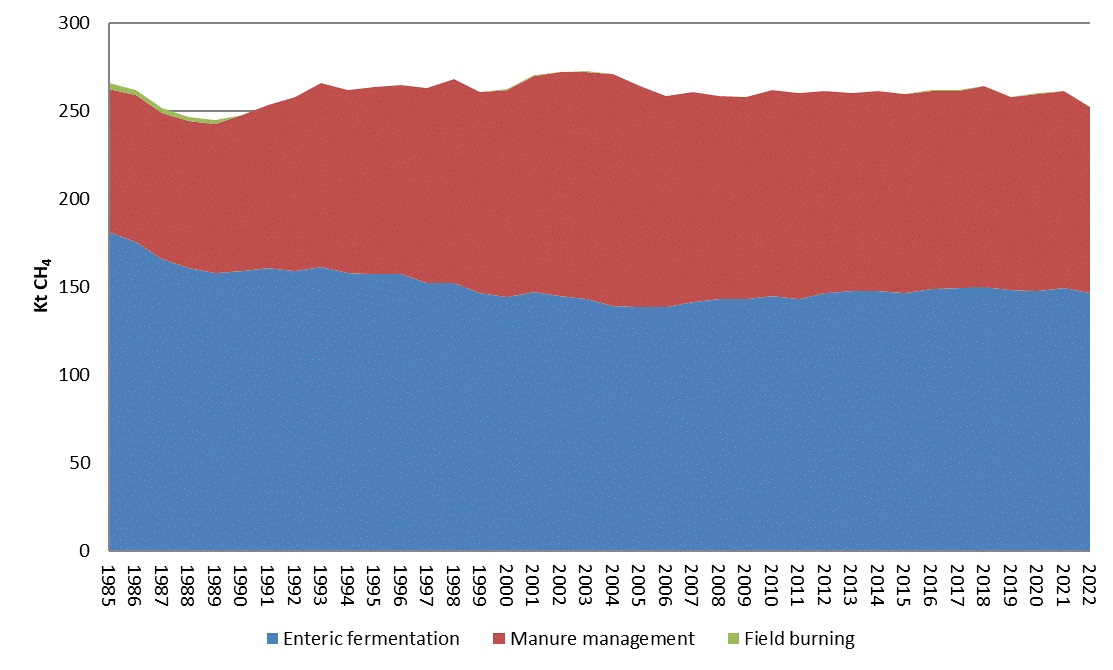 |
|---|---|
| Click here for background data | Click here for background data |
 | |
| Click here for background data |
Some background information can be found here:
NH3 emissions (data from the IIR report)
GHG emissions (data from the NID report)
Other data which the inventories are based on are represented for all years in tables linked below:
Table 1: GHG emission from enteric fermentation and manure management.
Table 2: Implied CH4 emission factor for animals - Enteric fermentation.
Table 3: Implied CH4 emission factor for animals - Manure management.
Table 4: Emission of NH3 from manure management divided on housing, storage, application and grazing.